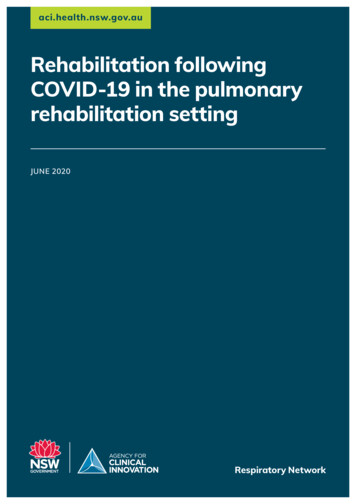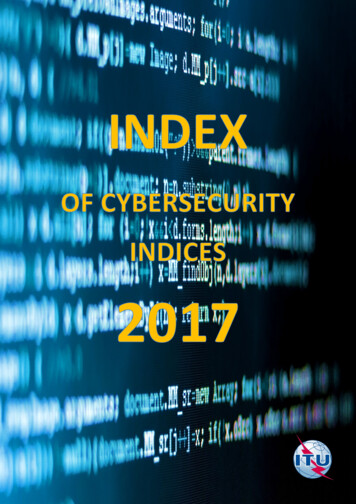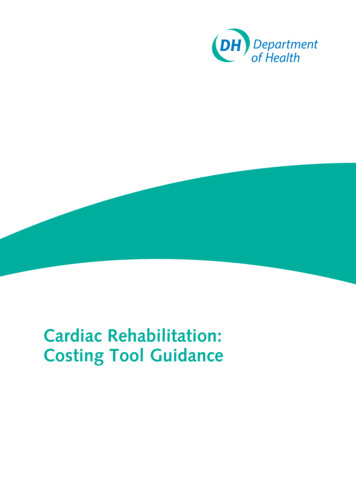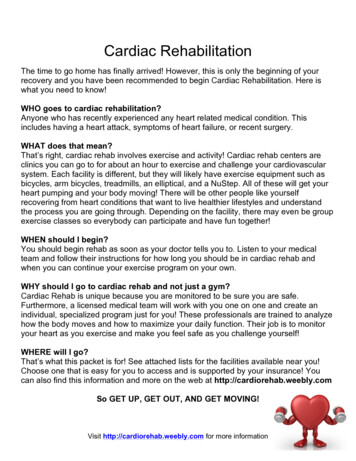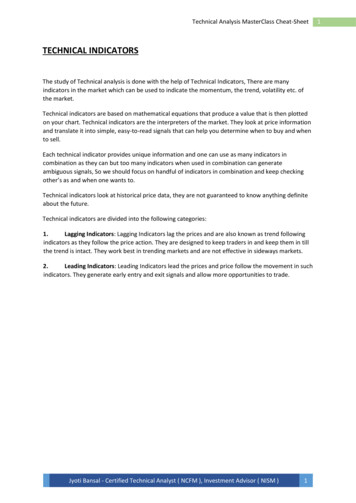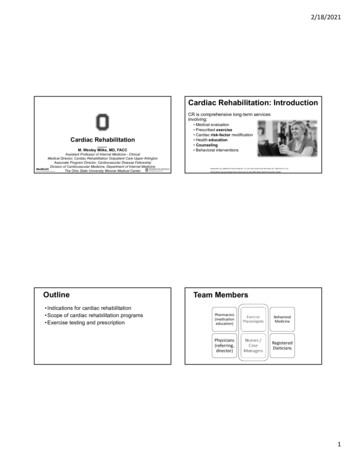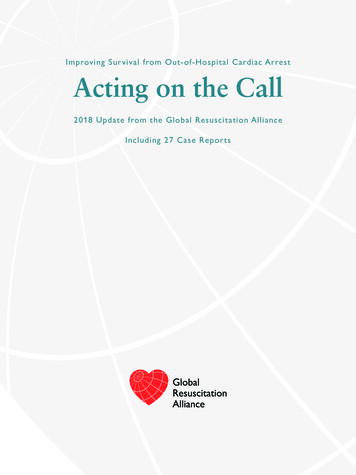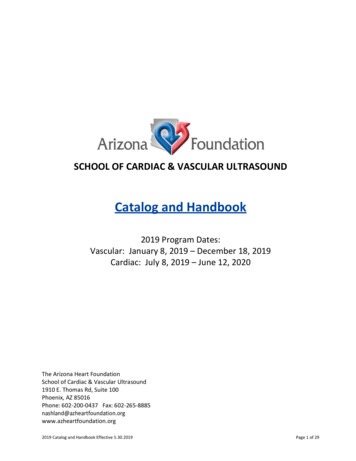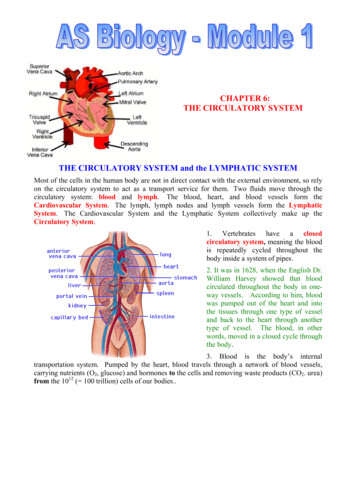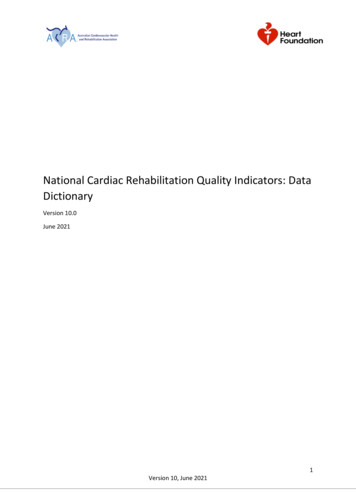
Transcription
National Cardiac Rehabilitation Quality Indicators: DataDictionaryVersion 10.0June 20211Version 10, June 2021
National Heart Foundation of Australia (National Cardiac Rehabilitation Measurement Taskforce)National Cardiac Rehabilitation Quality Indicators: data dictionary. Version 10.0. June 2021 2021 National Heart Foundation of Australia ABN 98 008 419 761Terms of use: This document has been produced by the Heart Foundation for the information of healthprofessionals. The statements and recommendations contained are, unless labelled as ‘expert opinion’, basedon independent review of the available evidence at the time of writing. Interpretation of this document bythose without appropriate medical and/or clinical training is not recommended other than under the guidanceof, or in consultation with, a suitably qualified health professional.While care has been taken in preparing the content of this material, the Heart Foundation and its employeesdo not accept any liability, including for any loss or damage, resulting from the reliance on the content, or itsaccuracy, currency and completeness. The information is obtained and developed from a variety of sourcesincluding, but not limited to, collaborations with third parties and information provided by third parties underlicence. It is not an endorsement of any organisation, product or service. Any use of Heart Foundationmaterials or information by another person or organisation is at the user's own risk.This work, except as identified below, is licensed by the Heart Foundation under a Creative CommonsAttribution – Non-commercial – No Derivative Works (CC BY-NC-ND) 4.0 Australia licence. To view a copy ofthis licence, visit: http://creativecommons.org.au/. You are free to copy and communicate this publication(however in no way commercialise the material), in accordance with the rules of attribution set out d party material that is not licenced under a Creative Commons licence may be referenced within thisdocument. All content not licensed under a Creative Commons licence is all rights reserved. Please contact therelevant third-party copyright owner if you wish to use this material.Acknowledgement: This document was based on: National Heart Foundation of Australia, NSW Agency for Clinical Innovation (ACI) and CardiovascularHealth and Rehabilitation Association NSW/ACT. NSW cardiac rehabilitation quality indicators datadictionary and definition guide 2017. International Council of Cardiovascular Prevention and Rehabilitation (ICCPR). International CardiacRehabilitation Registry. Data elements definitions 2.0. 2020 AuSCR Data Dictionary. Version 6.0. 2019 Available online: -program-bundles/The National Cardiac Rehabilitation Quality Indicators were developed by a Taskforce group originallycomprising the following members in October 2019:Rachelle ForemanProf Robyn GallagherA/Prof Carolyn AstleyDr Emma ThomasRobert ZecchinCate FerrySteve WoodruffeNational Heart Foundation of Australia (Co-chair), Brisbane, QLD, AustraliaAustralian Cardiovascular Health and Rehabilitation Association (Co-chair)The University of Sydney, Sydney, AustraliaSouth Australian Academic Health Science and Translation Centre, South AustralianHealth and Medical Research Institute, Adelaide, South AustraliaCentre for Online Health, Centre for Health Services Research, The University ofQueensland, Brisbane, AustraliaWestern Sydney Local Health District, Sydney, AustraliaNational Heart Foundation of Australia, Sydney, NSW, AustraliaWest Moreton Health, Ipswich, QLD, Australia2Version 10, June 2021
As of June 2021, the current members include:Prof Robyn GallagherThe University of Sydney, Sydney, AustraliaA/Prof Carolyn AstleySouth Australian Academic Health Science and Translation Centre, South AustralianHealth and Medical Research Institute, Adelaide, South AustraliaDr Emma ThomasCentre for Online Health, Centre for Health Services Research, The University ofQueensland, Brisbane, AustraliaRobert ZecchinWestern Sydney Local Health District, Sydney, AustraliaCate FerryNational Heart Foundation of Australia, Sydney, NSW, Australia (Co-chair)Prof Tom BriffaUniversity of Western Australia, Perth, AustraliaProf Julie RedfernThe University of Sydney, Sydney, AustraliaSamara PhillipsMetro South Health, Queensland, AustraliaKim GrayAustralian Cardiovascular Health and Rehabilitation Association (Co-chair)Suggested citation: National Cardiac Rehabilitation Measurement Taskforce. National Cardiac RehabilitationQuality Indicators: Data Dictionary. Version 10.0. June 2021.3Version 10, June 2021
ContentsPreamble . 5Using the data dictionary . 7Summary – Data elements (Section A) . 9Summary - Australian Cardiac Rehabilitation Quality Indicators (Section B) . 10SECTION A . 11PRE-PROGRAM . 12IDENTIFIABLE INFORMATION. 12SOCIO-DEMOGRAPHIC INFORMATION . 13REFERRAL INFORMATION . 14INITIAL ASSESSMENT. 16POST PROGRAM . 18RE-ASSESSMENT. 18SERVICE DELIVERY INFORMATION . 21SECTION B . 24CR QUALITY INDICATOR – 1 . 25CR QUALITY INDICATOR – 2 . 26CR QUALITY INDICATOR – 3 . 27CR QUALITY INDICATOR – 4 . 28CR QUALITY INDICATOR – 5 . 29CR QUALITY INDICATOR – 6 . 30CR QUALITY INDICATOR – 7 . 31CR QUALITY INDICATOR – 8 . 32CR QUALITY INDICATOR – 9 . 33CR QUALITY INDICATOR – 10 . 34Appendix A. International classification of disease (ICD) codes eligible for cardiac rehabilitation orsecondary prevention referral. . 35References . 374Version 10, June 2021
PreambleCare quality is an increasing focus of funders, providers and consumers of healthcare. Measuringquality and the clinical effectiveness of health services is important for ensuring accountability ofhealthcare providers, enhancing patient outcomes, minimising adverse events and aligning care withwhat patients want and the best available evidence.Quality indicators are explicitly defined statements that aim to measure adherence to aspects ofevidence-based care that are deemed necessary for reaching optimal patient outcomes and providea basis for quality improvement projects.1,2The need for Australian cardiac rehabilitation (CR) quality indicators was determined at a Think Tankon improving CR measurement, which was held on 26 September 2018 at the South AustralianAdvanced Health Research and Translation Centre and was attended by researchers, clinicians,policymakers and consumers with representation from each state and territory. The aim of the ThinkTank was to discuss state-based CR quality activities and future national directions and it was agreedthat a national set of quality indicators for CR service measurement was required.A Taskforce, co-chaired by the National Heart Foundation of Australia and the AustralianCardiovascular Health and Rehabilitation Association (ACRA), was established to progress thedevelopment of the quality indicators. The purpose of the quality indicators is to setrecommendations for what should be collected and reported on at a minimum so that CR programscan collect uniform data.The Taskforce developed a draft set of 11 quality indicators and disseminated these to ACRAmembers for feedback, via email and at the 2019 ACRA Annual Scientific Meeting, on their perceivedimportance to: (i) clinicians, (ii) managers, and (iii) patients, as well as the feasibility of collecting theindicators. Based on feedback, one indicator (waist circumference) was removed. This process hasbeen published in the following editorial: Gallagher R, Thomas E, Astley C, Foreman R, Ferry C, Zecchin R, Woodruffe S. CardiacRehabilitation Quality in Australia: Proposed National Indicators for Field-Testing. Heart,Lung and Circulation. 2020 Epub Apr 30.This document provides the proposed 10 quality indicators developed by the Taskforce along with adescription of how the indicators can be defined and measured. To collect this information a numberof data elements need to be collected at two time points – pre and post-CR.1 Spertus JA, Eagle KA, Krumholz HM, Mitchell KR, Normand SL and American College of Cardiology/American Heart Association Task Forceon Performance M. American College of Cardiology and American Heart Association methodology for the selection and creation ofperformance measures for quantifying the quality of cardiovascular care. J Am Coll Cardiol. 2005; 45: 1147-56.2Campbell SM, Braspenning J, Hutchinson A and Marshall M. Research methods used in developing and applying quality indicators inprimary care. Quality & Safety in Health Care. 2002; 11: 358-64.5Version 10, June 2021
The purpose of this document is to guide CR services in the type of information they should collecton every patient referred to their service. We provide a standardised format for data collection toensure information is collected consistently across sites and provides a basis for comparison andreporting across sites. The purpose of the national CR quality indicators is not to duplicate effortbut to ensure a) services that do not collect data have guidance on what to collect, b) services thatare collecting data are doing so in a standardised way and c) services go beyond collecting data tomeasuring care quality against the quality indicators described within this document.The National Cardiac Rehabilitation Measurement Taskforce is NOT collecting or collating thisinformation. Services are required to collect and securely save their own data. Each state is atdifferent levels of organisational readiness regarding how they collect and collate this information.The Taskforce will be evaluating the feasibility, acceptability, and usefulness of the qualityindicators in the future.6Version 10, June 2021
Using the data dictionaryThis data dictionary is divided into 2 sections: Section A: the data elementso To calculate the quality indicators, each service needs to collect several dataelements for each eligible CR patient at two time points: Pre and post the CRprogramo To assist with standardised data collection, each data element contains thefollowing information: reference number, common name, description, codes andvalues, help notes. Section B: the quality indicators (with reference to Section A as needed)o Once the data elements have been collected, they can be used to determine thequality indicators over a determined reference period (the recommended minimumperiod of assessment is annually).The following terms are frequently used throughout the document and are defined below.Table 1. Common termsTermCR DefinitionA CR program that provides exercise training, health behaviour change andeducation regarding lifestyle risk factor management, psychosocial health,medical risk factor management, and cardio-protective medicationsassessment and monitoring.Eligible patients for the purpose of measuring the quality indicators includepatients hospitalised with any of the following procedures/conditions orinterventions listed below: Acute myocardial infarction (STEMI, non-STEMI) (see Appendix A for ICDcodes) Percutaneous coronary intervention (see Appendix A for ICD codes) Coronary artery bypass surgery (see Appendix A for ICD codes) Valve surgery (see Appendix A for ICD codes) Atrial fibrillation, heart failure, unstable angina, arrhythmia, anginapectoralis, congenital heart disease, automatic implantable cardioverterdefibrillatorEnrolment is defined as patient registration into the CR program andattendance at the first CR program visit (including an assessment session).A comprehensive assessment is defined as the assessment of exercisecapacity, lifestyle risk factors (smoking, diet, physical activity), psychosocialhealth status, clinical risk factors (e.g. blood pressure) and use of cardioprotective medication. Additionally, it should include assessment of thepatient’s secondary prevention needs.7Version 10, June 2021
CompletionHealth relatedquality of life(HRQoL)IndividualisedmanagementplanReference periodReferredThe assessment is finalised when the discussion and agreement ofindividualised goals to be achieved during CR has been completed, with awritten self-management plan and a copy made available to the patientand/or family.To complete the CR program a patient must have participated in at leastsome of the CR intervention components (guided by a health professional)and have had a documented re-assessment.HRQoL is a patient reported outcome measure that takes into account thepatient’s emotional, social, and physical well-being.An individualised management plan is designed to promote the safe andtimely transition of patients between different health care providers andacross care settings.Reference period is defined as the time span of data collection that isincluded in analysis. The recommended minimum period of assessment isannually.A referral is defined as an official written or electronic communication onbehalf of any health care provider (including CR staff) to CR.8Version 10, June 2021
Summary – Data elements (Section A)Overview of data elementsPre-programIdentifiable information1.2.3.4.5.6.Referral informationPatient record IDFirst nameLast nameHospital medical record numberMedicare numberDate of birth12. Hospital discharge date13. CR referral date14. Principal referral diagnosisInitial assessmentSocio-demographic information7.8.9.10.11.AgeSex Recorded at BirthAboriginal and Torres Strait Islander statusInterpreter neededPostcode15.16.17.18.19.20.21.22.Initial assessment dateDepression screeningDepression referralSmoking statusSmoking referralMedication adherenceExercise capacityHealth-related quality of 30.31.Service delivery informationRe-assessment dateRe-assessment depression screeningRe-assessment depression referralRe-assessment smoking statusRe-assessment smoking referralRe-assessment medication adherenceRe-assessment of exercise capacityChange in exercise capacityRe-assessment of health-related quality oflife32. Change in health-related quality of life33. Care transition34.35.36.37.Mode of program deliveryFrequency of program deliveryContent of programNumber of supervised exercise sessionsattended38. CR completion39. Reason for CR non-completion9Version 10, June 2021
Summary - Australian Cardiac Rehabilitation Quality Indicators(Section B)The table below provides a summary of the 10 quality indicators for CR. Some indicators aim toevaluate processes of care (process indicators,) while others evaluate the outcomes of CR (outcomeindicators). These are colour co-ordinated as per the key below the figure.Overview of cardiac rehabilitation quality indicatorsQI-1. Referral to CREligible in-patients are referred to cardiac rehabilitation within 3 calendar days after hospital discharge.QI-2. Time to enrolmentEligible in-patients commence cardiac rehabilitation within 28 calendar days after hospital discharge.QI-3. Comprehensive assessmentPatients who commence cardiac rehabilitation receive a comprehensive assessment of cardiovascular riskfactors.QI-4. Depression screeningPatients who commence cardiac rehabilitation are screened for depression at initial and re-assessment andoffered counselling (or referral to counselling) if symptoms are identified.QI-5. Assessment of smokingPatients who commence cardiac rehabilitation are assessed for smoking use at initial and re-assessment andoffered smoking cessation counselling (or referral to counselling) if they are a current or recent smoker.QI-6. Assessment of medication adherencePatients who commence cardiac rehabilitation are assessed for medication adherence at initial and reassessment.QI-7. Assessment of exercise capacityPatients who commence cardiac rehabilitation have an initial assessment and re-assessment to determineexercise capacity change.QI-8. Assessment of health-related quality of lifePatients who commence cardiac rehabilitation have an initial assessment and re-assessment to determinehealth-related quality of life change.QI-9. Re-assessmentPatients who participate in cardiac rehabilitation receive a comprehensive re-assessment of theircardiovascular risk factors.QI-10. Care transitionPatients and ongoing care providers are provided with a report which outlines patient risk factors and anindividualised ongoing management plan.Process indicatorOutcome indicator10Version 10, June 2021
SECTION A11Version 10, June 2021
PRE-PROGRAMThe following information should be collected for each eligible CR patient and stored securely byeach service according to institutional protocols and should not be shared beyond the service-levelunless clear data sharing approvals and governance structures are in place.IDENTIFIABLE INFORMATIONPatient record IDReference numberDescriptionCodes and valuesHelp notes1This number represents a unique identifier that indicates which clinical record thispatient relates to but does not identify the patient’s identity.Free textServices should ensure patient record IDs are provided in a systematic andconsistent way. Each patient record ID is unique for each episode of care. Thisnumber is useful to identify records whilst observing confidentiality of patientinformation. This should not be the patients MRN or URN.First nameReference numberDescriptionCodes and valuesHelp notes2The person’s identifying name within the family group or by which the person issocially identified, as represented by text.Free textThe format in which it is written should be the same as that indicated by the person(e.g. written on a form) or in the same format as that printed on an identificationcard, such as a Medicare card, to ensure consistent collection of name data.Last nameReference numberDescriptionCodes and valuesHelp notes3That part of a name a person usually has in common with some other members ofhis/her family, as distinguished from his/her first or given names, as represented bytext.Free textThe full family name should be recorded. The format in which it is written should bethe same as that printed on an identification card, such as a Medicare card, toensure consistent collection of name data.Hospital medical record number (MRN)Reference numberDescriptionCodes and valuesHelp notes4Person identifier unique within an establishment or agency also known as UnitRecord Number (UR) and Patient Record Number.Free text.The MRN is collected to assist in individual patient identification and to identifypotential duplicates in the database. It is useful for linking the CR patient with theirhospital record to determine the number of eligible patients that were referred toCR.12Version 10, June 2021
Medicare number (once data-linked)Reference numberDescriptionCodes and valuesHelp notes5Number on the person’s Medicare Card used as an Australian CommonwealthGovernment identifier.Free textThe full Medicare number for an individual should be recorded, without includingthe person (individual reference) number. For example, John Smith’s full Medicarenumber is 1234567890For overseas visitors or patients without Medicare Card please leave blankDate of birthReference numberDescriptionCodes and valuesHelp notes6The date of birth of the person.DD/MM/YYYYIf day of birth is unknown, use 01 for the day (01/MM/YYYY). If the day and monthof birth are unknown, use 01 for the day and month (01/01/YYYY).SOCIO-DEMOGRAPHIC INFORMATIONAgeReference numberDescriptionCodes and valuesHelp notes7The age in completed years at the time of CR referral.DD/MM/YYYYSubtract current date from DOBSex Recorded at BirthReference numberDescriptionCodes and valuesHelp notes8The sex recorded at birth (male, female, non - binary) that the person identifies as.1 Male2 Female3 Non-binary sex – people who reported their sex as non – binary sex99 Not stated / inadequately describedSex recorded at birth should be captured as it is written in the medical record. Ifthere is a conflict, document with the self-identified sex recorded at birth, i.e. sexrecorded at birth as reported by the person.Aboriginal and Torres Strait Islander statusReference numberDescriptionCodes and values9Whether a person identifies as being of Australian Indigenous, Aboriginal or TorresStrait Islander origin.1 No2 Yes Aboriginal origin3 Yes Torres Strait Islander origin13Version 10, June 2021
Help notes4 Yes both Aboriginal and Torres Strait Islander origin5 Missing/not statedAboriginal or Torres Strait Islander origin status should be captured as it is writtenin the medical record. If there is a conflict, document with the self-identified origin,i.e. origin as reported by the person.Interpreter neededReference numberDescriptionCodes and valuesHelp notes10Whether an interpreter service is required for the patient to participate in CR.1. Yes2 NoIncludes whether an approved interpreter service is required. Any form of signlanguage should also be coded as ‘Yes’.Post codeReference numberDescriptionCodes and valuesHelp notes11The numeric descriptor for a postal delivery area, aligned with locality, suburb orplace for the address of a person. METeOR Identifier: 611398Free textLeave blank when the locality name or geographic area for a person is not known,or when a person has no fixed address. For person’s visiting from overseas, recordtheir local Australian address.REFERRAL INFORMATIONPlease note that all referred patients’ information should be entered (not just those who attend theinitial assessment) so that the proportion of referred patients enrolling can be assessed.Hospital discharge dateReference numberDescriptionCodes and valuesHelp notes12The date the patient was discharged from an acute episode of care.DD/MM/YYYYThe patient may have several inpatient separations during a single acute episode ofcare (i.e. short stay unit to ward to ICU to ward). The final date of discharge fromthe acute episode of care should be used. May source from patient’s medicalrecord, CR referral log.CR referral dateReference numberDescriptionCodes and valuesHelp notes13Date CR referral document was signed by referring healthcare providerDD/MM/YYYY)May source from patient’s medical record, CR referral log, GP letterPrincipal referral diagnosis/InterventionsReference numberDescriptionCodes and values14aThe referral diagnosis refers to the most recent diagnosis preceding the patient’sreferral to cardiac rehabilitation.Select from below1. STEMI2. NSTEMI3. CABG14Version 10, June 2021
Help notesReference numberDescriptionCodes and valuesHelp notesReference numberDescriptionCodes and valuesHelp notes4. Valve Sx5. Elective PCI6. Heart Failure (HFrEF, HFpEF)7. Arrhythmia8. AICD/PPM9. Angina Pectoralis10. Congenital Heart Disease11. Congenital Heart Sx12. TAVI13. OtherPlease use ICD codes to guide selection (See Appendix A). There may be more thanone possible referral diagnosis reported if the second occurred within the samehospitalization period. DO NOT report historical diagnoses/interventions. Maysource from patient’s medical record, CR referral log. AICD Automatic implantablecardioverter defibrillator; ICD International Classification of DiseasePPM permanent pacemaker14bAdditional diagnosis/interventionsSelect from below1. CABG Sx2. Valve Sx3. Primary PCI4. Staged PCI5. Elective PCI6. Heart Failure (HFrEF, HFpEF)7. Arrhythmia8. AICD/PPM9. Congenital Heart Sx10. TAVI11. Other12. Medical ManagementThere may be more than one possible referral diagnosis reported if the secondoccurred within the same hospitalization period. DO NOT report historicaldiagnoses/interventions. May source from patient’s medical record, CR referral log.14cAdditional diagnosis/interventionsSelect from below1. CABG Sx2. Valve Sx3. Primary PCI4. Staged PCI5. Elective PCI6. Heart Failure (HFrEF, HFpEF)7. Arrhythmia8. AICD/PPM9. Congenital Heart Sx10. TAVI11. Other12. Medical ManagementThere may be more than one possible referral diagnosis reported if the secondoccurred within the same hospitalization period. DO NOT report historicaldiagnoses/interventions. May source from patient’s medical record, CR referral log.15Version 10, June 2021
INITIAL ASSESSMENTInitial assessment dateReference numberDescriptionCodes and valuesHelp notes15Enter the date of the initial assessment took place i.e. the date the patient hadtheir initial visit at CR for assessment of risk, history, etc.DD/MM/YYYYMay source from CR administrative database, initial assessment information.Depression screeningReference numberDescriptionCodes and valuesHelp notes16Was the patient screened for depression using a valid and reliable screening tool?0 Yes1 NoIf no provide reason for not screening [open text].If yes, please document the depression scores and the depression screening toolused.May source from patient’s medical record, patient initial assessment.Suggested tools include (but are not limited to) the following: the Patient HealthQuestionnaire (PHQ) -2 and PHQ-9, the Hospital Anxiety and Depression Screener(HADS), the Cardiac Depression Screener (CDS), the Beck Depression Inventory(BDI-II), and the Kessler Psychological Distress Scale (Kessler-10).Depression referralReference numberDescriptionCodes and valuesHelp notes17Patients who screen positive for depression were offered/referred for counselling0 Yes1 No99 N/AIf no select reason for not referring for further management [optional]DeclinedUnder current treatmentUnknownOtherMay source from patient’s medical record (i.e. documentation of referral orcounselling support provided).Smoking statusReference numberDescriptionCodes and values18Was the CR patient’s smoking status assessed?0 Yes1 No99 UnknownIf no provide reason for not screening.If yes, document smoking status1 Daily smoker (A person who smokes daily)2 Weekly smoker (A person who smokes at least weekly but not daily)3 Irregular smoker (A person who smokes less than weekly)4 Ex-smoker (A person who does not smoke at all now, but has smoked at least100 cigarettes or similar amount of other tobacco products in his/her lifetime)16Version 10, June 2021
5Help notesNever-smoker (A person who does not smoke now and has smoked fewer than100 cigarettes or similar amount of other tobacco products in his/her lifetime99 UnknownMay source from patient’s medical record, patient initial assessment, self-report.Smoking referralReference numberDescriptionCodes and valuesHelp notes19Patients who are current or recent smokers were offered smoking cessationcounselling (or were referred to counselling).0 Yes1 No99 UnknownIf no, select reason for not offering smoking cessation counselling (or a referral tocounselling)N/ADeclinedUnder current treatmentUnknownMay source from patient’s medical record (i.e. documentation of referral orsmoking cessation support provided).Medication adherenceReference numberDescriptionCodes and valuesHelp notes20Medication adherence was assessed?0 Yes1 No99 UnknownIs the patient adhering to prescribed treatment0 Yes1 No3 UnknownReason for non-adherenceCostCognitive issuesSide effects/ContraindicationPatient choiceUnknownMay source from
Health and Rehabilitation Association NSW/ACT. NSW cardiac rehabilitation quality indicators data dictionary and definition guide 2017. International Council of Cardiovascular Prevention and Rehabilitation (ICCPR). International Cardiac Rehabilitation Registry. Data elements definitions 2.0. 2020 AuSCR Data Dictionary.
